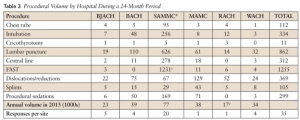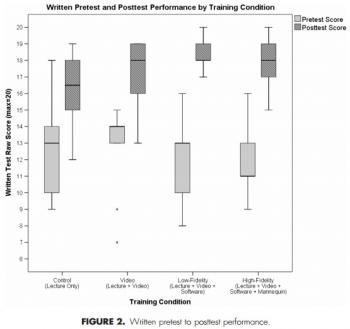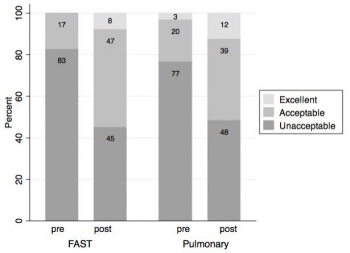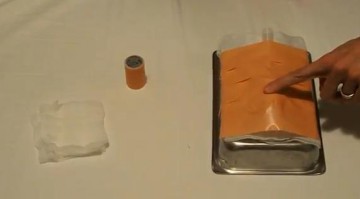12/09/2016
L'hôpital de proximité: Insuffisant ?
Garrison Clinical Setting Inadequate for Maintenance of Procedural Skills for Emergency Medicine Physicians: A Cross-Sectional Study
Schauer SG et Al. J Spec Oper Med. 2015 Winter;15(4):67-70
----------------------------------------
Lire également cet éditorial qui pointe l'insuffisance de l'exercice en hôpital de proximité avec le rôle important que peut jouer la simulation. Les auteurs proposent un maintien longitudinal des compétences avec des minima en termes de pratiques gestuelles avant projection.
----------------------------------------
BACKGROUND:
Emergency medicine physicians (EPs) are often placed in far-forward, isolated areas in theater. Maintenance of their emergency intervention skills is vital to okeep the medical forces deployment ready. The US Army suggests that working at a Military Treatment Facility (MTF) is sufficient t keep emergency procedural skills at a deployment-ready level. We sought to compare the volume of emergency procedures that providers reported necessary to maintain their skills with the number available in the MTF setting.
METHODS:
EPs were surveyed to quantify the number of procedures they reported they would need to perform yearly to stay deployment-ready. We obtained procedure data for their duty stations and compared the procedure volume with the survey responses to determine if working at an MTF is sufficient to keep providers' skills deployment ready.
RESULTS:
The reported necessary average numbers per year were as follows: tube thoracostomy (5.9), intubation (11.4), cricothyrotomy (4.2), lumbar puncture (5.2), central line (10.0), focused assessment with sonography for trauma (FAST) (21.3), reductions (10.6), splints (10.5), and sedations (11.7). None of the procedure volumes at MTFs met provider requirements with the exception of FAST examinations at the only trauma center.
CONCLUSIONS:
This suggests the garrison clinical environment is inadequate for maintaining procedure skills. Further research is needed to determine modalities that will provide adequate training volume.
01/09/2016
Pensez, efficace et peu couteux
Cognitive skills analysis, kinesiology, and mental imagery in the acquisition of surgical skills
Bathalon S. et Al. J Otolaryngol. 2005 Oct;34(5):328-32.
--------------------------------------------
Un moyen simple pour améliorer sa performance
--------------------------------------------
GOAL:
Isolate and evaluate the impact of mental imagery on the acquisition of an emergency surgical technique.
METHOD:
We studied 44 first-year medical students performing a cricothyrotomy on a mannequin to determine the impact of teaching usingmental imagery (MI) and/or kinesiology (KG) compared to the standard Advandec Trauma Life Support (ATLS) approach. Students were randomly assigned to one of three groups: MI and KG, KG alone or control (ATLS). Two weeks after the one-hour teaching session, they were evaluated with an OSCE testing the performance of the different steps of the technique, the time required and its fluidity.
RESULTS:
Total results (maximum: 25 marks) are as follows: KG + MI = 20.3 +/- 1.5 ; KG = 19.3 +/- 2.9 ; ATLS = 18.2 +/- 2.5. The only statistically significant difference for total results was in the use of MI and KG compared to the control group. Kinesiology alone or with mental imageryimproved the fluidity of the performance.
CONCLUSION:
Many factors influence the acquisition of a surgical technique. This study showed that acquisition and performance of an emergency procedure (cricothyrotomy) was improved when mental imagery and kinesiology were combined to teach it.
04/08/2016
Le cône d'apprentissage de Dale: Quèsaco ?
J'entends et j'oublie,
Je vois et je me souviens,
Je fais et je comprends

30/01/2016
Coniotomie: Modèle porcin
A porcine model for teaching surgical cricothyridootomy
Netto FA et Al. Rev Col Bras Cir. 2015 Jun;42(3):193-6

Le matériel nécessaire

Le montage

Un gant fixé derrière la peau va simuler la membrane

Le simulateur prêt à l'emploi.
| Tags : coniotomie
17/12/2015
Tourniquet:Oui, mais bien posé= Serrer FORT
Evaluation of rapid training in ultrasound guided tourniquet application skills
Jaffer U. et Al. International Journal of Surgery 10 (2012) 563-567
-------------------------------------------------
Il existe actuellement un engouement justifié pour l'emploi du tourniquet comme moyen d'hémostase. Néanmoins il est important de rappeler que la pose d'un garrot a pour objectif l'arrêt d'un saignement important le plus souvent d'origine artérielle. Ils se doivent donc d'être serrés fort. Le travail proposé rappelle que la formation à la pose d'un garrôt n'est pas simplement sa manipulation mais qu'elle doit porter de manière spécifique sur les critères d'arrêt du saignement. En effet dans un modèle classique d'instruction de pose sur patient sain, les critères d'arrêt du serrage ne correspondent pas à ceux nécessaires en réel. Dans le travail proposé la pose à l'aveugle d'un garrot ne permet d'obtenir l'arrêt du saignement que dans moins d'1/4 à 1/5 des cas. Un enseignement donc à conduire par ceux qui en ont une pratique avancée. L'apport de simulateurs de saignement objectif comme celui du TOMMAN est certainement très intéressant.
Pour info: Fiche memento Garrot tactique
-------------------------------------------------
Tourniquet application has been widely accepted to improve survival for major limb trauma. Colour duplex ultrasound (US) can be used as a non-invasive method of confirming cessation of arterial flow. Participants with no or limited experience of ultrasound were taught to apply the Tourniquet with ultrasound guidance. Following this, participants were tested in effective tourniquet application: Blind and with ultrasound guidance. US guidance improved abolition of limb perfusion from 22 to 93 per cent in upper limb; from 25 to 100 per cent in lower limb (p ¼ 0.0027 and <0.0001).


Membre Sup Membre inf
No significant difference was found in application time for the lower limb; less time was taken for application with US guidance in the upper limb 8.1 (7.1, 8.6) vs 4.5 s (4.0, 5.3; median (IQR)), p ¼ 0.002. Tourniquet ultrasound skills are rapidly acquired by novice operators. Accuracy improves with ultrasound guidance, this may have a role in improving survival.
30/10/2015
Echographie: De l'expérience SVP
Does physician experience influence the interpretability of focused echocardiography images performed by a pocket device?
Bobbia X et al. Scandinavian Journal of Trauma, Resuscitation and Emergency Medicine (2015) 23:52
---------------------------------------------------------------
Il existe un très grand engouement concernant l'emploi d'échographe dit de poche. Cet article appelle a être plus circonspect. Sil il s'agit bien de faire rentrer l'échographie dans la pratique quotidienne, encore faut il que cela soit assorti d'une qualification réelle.
---------------------------------------------------------------
Introduction: The use of focused cardiac ultrasound (FoCUS) in a prehospital setting is recommended. Pocket ultrasound devices (PUDs) appear to be well suited to prehospital FoCUS. The main aim of our study was to evaluate the interpretability of echocardiography performed in a prehospital setting using a PUD based on the experience of the emergency physician (EP).
Methods: This was a monocentric prospective observational study. We defined experienced emergency physicians (EEPs) and novice emergency physicians (NEPs) as echocardiographers if they had performed 50 echocardiographies since their initial university training (theoretical training and at least 25 echocardiographies performed with a mentor). Each patient undergoing prehospital echocardiography with a PUD was included. Four diagnostic items based on FoCUS were analyzed: pericardial effusions (PE), right ventricular dilation (RVD), qualitative left ventricular function assessment (LVEF), and inferior vena cava compliance (IVCC). Two independent experts blindly evaluated the interpretability of each item by examining recorded video loops. If their opinions were divided, then a third expert concluded.
Results: Fourteen EPs participated: eight (57 %) EEPs and six (43 %) NEPs. Eighty-five patients were included: 34 (40 %) had an echocardiography by an NEP and 51 (60 %) by an EEP. The mean number of interpretable items by echocardiography was three [1; 4]; one [0; 2.25] in the NEP group, four [3; 4] in EEP (p < .01). The patient position was also associated with interpretable items: supine three [2; 4], “45°” three [1; 4], sitting two [1; 4] (p = .02). In multivariate analysis, only EP experience was associated with the number of interpretable items (p = .02). Interpretability by NEPs and EEPs was: 56 % vs. 96 % for LVF, 29 % vs. 98 % for PE, 26 % vs. 92 % for RVD, and 21 % vs. 67 % for IVCC (p < .01 for all).
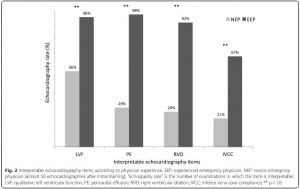
Conclusion: FoCUS with PUD in prehospital conditions was possible for EEPs, It is difficult and the diagnostic yield is poor for NEPs.
| Tags : échographie
01/09/2015
Grimage ou mannequins ? Les 2 svp !
A comparison of live tissue training and high-fidelity patient simulator: A pilot study in battlefield trauma training
Savage EC et Al. J Trauma Acute Care Surg. 2015;00: 00_00[Epub ahead of print].
BACKGROUND:
Trauma procedural and management skills are often learned on live tissue. However, there is increasing pressure to use simulators because their fidelity improves and as ethical concerns increase. We randomized military medical technicians (medics) to training on either simulators or live tissue to learn combat casualty care skills to determine if the choice of modality was associated with differences in skill uptake.
METHODS:
Twenty medics were randomized to trauma training using either simulators or live tissue. Medics were trained to perform five combat casualty care tasks (surgical airway, needle decompression, tourniquet application, wound packing, and intraosseous line insertion). We measured skill uptake using a structured assessment tool. The medics also completed exit questionnaires and interviews to determine which modality they preferred.
RESULTS:
We found no difference between groups trained with live tissue versus simulators in how they completed each combat casualty care skill. However, we did find that the modality of assessment affected the assessment score. Finally, we found that medics preferred trauma training on live tissue because of the fidelity of tissue handling in live tissue models. However, they also felt that training on simulators also provided additional training value.
CONCLUSION:
We found no difference in performance between medics trained on simulators versus live tissue models. Even so, medics preferred live tissue training over simulation. However, more studies are required, and future studies need to address the measurement bias of measuring outcomes in the same model on which the study participants are trained.
19/08/2015
Simuler en haute fidélité: Pas si sûr !
A Comparison of Teaching Modalities and Fidelity of Simulation Levels in Teaching Resuscitation Scenarios
Adams AJ et Al. J Surg Ed 2015, 72:778-785
-------------------------------
Il existe un très grand engouement pour le recours à la simulation haute fidélité, ce qui n'est pas sans impact financier. Un mannequin sophistiqué serait le gage d'une meilleure qualité de formation. Il semble que les bases scientifiques de ces démarches ne sont pas aussi solides que cela du moins pour les novices. Cet article a le mérite de montrer que l'on peut parfaitement conduire une formation de qualité avec des moyens plus conventionnels.
-------------------------------
Introduction
The purpose of our study was to examine the ability of novices to learn selected aspects of Advanced Cardiac Life Support (ACLS) in training conditions that did not incorporate simulation compared to those that contained low- and high-fidelity simulation activities. We sought to determine at what level additional educational opportunities and simulation fidelity become superfluous with respect to learning outcomes.
Methods
Totally 39 medical students and physician assistant students were randomly assigned to 4 training conditions: control (lecture only), video-based didactic instruction, low-, and high-fidelity simulation activities. Participants were assessed using a baseline written pretest of ACLS knowledge. Following this, all participants received a lecture outlining ACLS science and algorithm interpretation. Participants were then trained in specific aspects of ACLS according to their assigned instructional condition. After training, each participant was assessed via a Megacode performance examination and a written posttest.
Results
All groups performed significantly better on the written posttest compared with the pretest (p < 0.001); however, no groups outperformed any other groups. On the Megacode performance test, the video-based, low-, and high-fidelity groups performed significantly better than the control group (p = 0.028, p < 0.001, p = 0.019). Equivalence testing revealed that the high-fidelity simulation condition was statistically equivalent to the video-based and low-fidelity simulation conditions.
Conclusion
Video-based and simulation-based training is associated with better learning outcomes when compared with traditional didactic lectures only. Video-based, low-fidelity, and high-fidelity simulation training yield equivalent outcomes, which may indicate that high-fidelity simulation is superfluous for the novice trainee.
01/08/2015
Simulation préhospitalière: Etat des lieux
Mapping the use of simulation in prehospital care - a literature review
Abelsson et al. Scandinavian Journal of Trauma, Resuscitation and Emergency Medicine 2014, 22:22
BACKGROUND:
High energy trauma is rare and, as a result, training of prehospital care providers often takes place during the real situation, with the patient as the object for the learning process. Such training could instead be carried out in the context of simulation, out of danger for both patients and personnel. The aim of this study was to provide an overview of the development and foci of research on simulation in prehospital care practice.
METHODS:
An integrative literature review were used. Articles based on quantitative as well as qualitative research methods were included, resulting in a comprehensive overview of existing published research. For published articles to be included in the review, the focus of the article had to be prehospital care providers, in prehospital settings. Furthermore, included articles must target interventions that were carried out in a simulation context.
RESULTS:
The volume of published research is distributed between 1984- 2012 and across the regions North America, Europe, Oceania, Asia and Middle East. The simulation methods used were manikins, films, images or paper, live actors, animals and virtual reality. The staff categories focused upon were paramedics, emergency medical technicians (EMTs), medical doctors (MDs), nurse and fire fighters. The main topics of published research on simulation with prehospital care providers included: Intubation, Trauma care, Cardiac Pulmonary Resuscitation (CPR), Ventilation and Triage.
CONCLUSION:
Simulation were described as a positive training and education method for prehospital medical staff. It provides opportunities to train assessment, treatment and implementation of procedures and devices under realistic conditions. It is crucial that the staff are familiar with and trained on the identified topics, i.e., intubation, trauma care, CPR, ventilation and triage, which all, to a very large degree, constitute prehospital care. Simulation plays an integral role in this. The current state of prehospital care, which this review reveals, includes inadequate skills of prehospital staff regarding ventilation and CPR, on both children and adults, the lack of skills in paediatric resuscitation and the lack of knowledge in assessing and managing burns victims. These circumstances suggest critical areas for further training and research, at both local and global levels.
| Tags : simulateurs
16/07/2015
S'entraîner pour son assurance personnelle : Combien ?
Training Modalities and Self-Confidence Building in ALS Providers
Ilia S et Al. . Mil Med. 2012 Aug;177(8):901-6.
-----------------------------------------------------------------------
Un document important qui aborde l'impact de la confiance en soi obtenu par l'entraînement. Plusieurs techniques d'entraînement doivent être associée: Simulation et monde réel. Le recours au modèle animal n'apparaît pas significatif. Des plateaux à partir desquels il faut opter pour une autre méthode sont identifiés: Pour l'intubation 30 sur mannequin et 25 en réel, 40 pour l'exsufflation sur mannequin et 3 en réel et 10 pose de KTIO sur simulateur.
-----------------------------------------------------------------------
OBJECTIVE:
Physicians and paramedics in the Israel Defense Forces are trained to perform advanced medical procedures using standardized training modalities, such as manikins. We studied the association of experience using these training modalities with self-reported confidence in procedure performance.
METHODS:
Providers were sent a questionnaire regarding their experience with and self-confidence levels for performing endotracheal intubation, cricothyroidotomy, needle chest decompression, tube thoracostomy, and intraosseous infusion.
RESULTS:
Provider level (physician or paramedic) and gender were associated with reported self-confidence levels. Manikin and supervised and unsupervised patient experience exhibited positive associations with self-confidence, but (animal) model experience did not. For many procedure-training modality pairs, we identified a plateau level above which additional experience was minimally associated with an increase in self-confidence.

CONCLUSIONS:
Among military advanced life support providers, self-confidence levels in procedure performance are positively associated with experience gained from manikins and supervised and unsupervised patient application. We were not able to demonstrate a clear benefit of an animal model in increasing self-confidence. A plateau was generally identified, indicating decreased benefit from the use of a particular training modality for a particular procedure. Modifying training regimens in light of these findings may help maximize the self-confidence of advanced life support providers more efficiently.
14/06/2015
Transfert de compétences: Oui si organisé !
Amélioration de l'offre des soins obstétricaux par la délégation des tâches en milieu africain Exemple de l'hôpital du district sanitaire de Bogodogo à Ouagadougou, Burkina Faso
Ouédraogo CM et Al. Médecine et Santé Tropicales 2015 ; 00 : 1-5
----------------------------------------------
La performance du sauvetage au combat tient à un transfert de compétences et savoir faire choisis et pour lesquels des personnels ont été spécifiquement formés. Ainsi la médicalisation de l'avant doit elle être comprise non pas la présence du médecin à l'avant mais la présence de savoir faire. Ce besoin déborde largement le contexte militaire et est bien connu dans les pays où l'infrastructure médicale n'est pas aussi développée qu'en métropole. Le document présenté exprime toute la puissance de ces transferts quand ils sont organisés et bien maîtrisés.
----------------------------------------------
Objectif : délégation de la pratique des interventions obstétricales majeures à des infirmiers spécialisés en chirurgie à l’hôpital de district de Bogodogo, Burkina Faso.
Méthode: Etude descriptive, analytique et non expérimentale comparant les prestations de gynécologues-obstétriciens et des infirmiers spécialisés en chirurgie pour des interventions obstétricales majeures. La collecte des données a été réalisée de février à octobre 2013 dans le service de gynécologie obstétrique de l’hôpital du district de Bogodogo. Ont été incluses dans l’étude les femmes qui ont bénéficié d’une intervention obstétricale majeure (IOM) en urgence, par un gynécologue obstétricien ou par un infirmier spécialisé en chirurgie. La collecte des données a été réalisée de février à octobre 2013 dans le service de gynécologie obstétrique de l’hôpital de district de Bogodogo, à l’aide d’une fiche (questionnaire) individuelle. Les données ont été saisies grâce au logiciel EPIDATA, version 3.1, et analysées par SPSS, version 22. Le test de Khi2 a permis la comparaison des proportions et celui de Student la comparaison des moyennes. Le seuil de significativité retenu était de 5%.
Résultats : Au cours de la période d’étude, nous avons colligé 601 cas d’interventions obstétricales majeures dont 65,4% réalisés par les gynécologues obstétriciens. L’âge moyen des femmes était de 26,7 ans. La césarienne était l’intervention obstétricale majeure la plus pratiquée avec fréquence de 90% suivi de la laparotomie avec une fréquence de 7,7%. Dans les cas de césarienne, la technique de Misgav-Ladach a été utilisée respectivement dans 86,5% et 95,3% par les gynécologues obstétriciens et les infirmiers spécialisés en chirurgie.

Conclusion : La délégation de tâches en chirurgie obstétricale est effective à l’hôpital du district de Bogodogo et sans risque selon les résultats de cette étude. Son extension au niveau national permettrait de combler le déficit en ressources humaines hautement qualifiées pour réaliser les IOM dans les hôpitaux de district des régions rurales
21/05/2015
Simulateurs d'airway: Fiables ?
A radiographic comparison of human airway anatomy and airway manikins – Implications for manikin-based testing of artificial airways
Schalk R et Al. Resuscitation. 2015 May 11. pii: S0300-9572(15)00199-9
----------------------------------------------------------
La maîtrise des techniques de contrôle des voies aériennes est un des enjeux de la médecine préhospitalière militaire. Le recours à la simulation est devenu très fréquent. Pour autant ce travail montre que cette méthode d'apprentissage a ses limites. L'une d'entre elle est le fait que les simulateurs de tache ne reproduisent pas correctement l'anatomie des voies aériennes.
----------------------------------------------------------
Objective
The aim of this prospective, single-center, observational study was to investigate the accuracy of modeling and reproduction of human anatomical dimensions in manikins by comparing radiographic upper airway measurements of 13 different models with humans.
Methods
13 commonly used airway manikins (male or female anatomy based) and 47 controls (adult humans, 37 male, 10 female) were investigated using a mediosagittal and axial cervical spine CT scan. For anatomical comparison six human upper airway target structures, the following were measured: Oblique diameter of the tongue through the center, horizontal distance between the center point of the tongue and the posterior pharyngeal wall, horizontal distance between the vallecula and the posterior pharyngeal wall, distance of the upper oesophageal orifice length of epiglottis distance at the narrowest part of the trachea. Furthermore, the cross-section of the trachea in axial view and the cross-section of the upper oesophageal orifice in the same section was calculated. All measurements were compared gender specific, if the gender was non-specified with the whole sample.
Results
None of the included 13 different airway manikins matched anatomy in human controls ( n = 47) in all of the six measurements. The Laerdal Airway Management Trainer, however, replicated human airway anatomy at least satisfactorily.
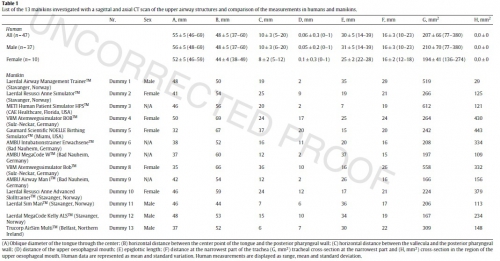
Conclusion
This investigation showed that all of the examined manikins did not replicate human anatomy. Manikins should therefore be selected cautiously, depending on the type of airway securing procedure. Their widespread use as a replacement for in vivo trials in the field of airway management needs to be reconsidered.
| Tags : airway
02/05/2015
Haute fidélité: Utile ? Pas si sûr
The use of high-fidelity manikins for advanced life support training. A systematic review and meta-analysis
Cheng A et All. Resuscitation. 2015 Apr 14. pii: S0300-9572(15)00152-5
---------------------------------------------------------
Le recours à la simulation apparaît incontournable en pédagogie médicale. L'emploi de mannequins haute fidélité connait un essort majeur. Si la satisfaction des étudiants semble au rendez-vous, il n'est cependant pas si évident que la simulation haute fidélité soit dimensionnante en terme d'acquisition réelle de savoir faire. Les avis sont partagés. Ainsi C'est travail évoque un niveau de preuve relativement faible voir absent. Compte tenu du coût non négligeable des mannequins haute fidélité, un tel investissement doit donc être réfléchi.
--------------------------------------------------------
Objectives:
The objective of this study was to evaluate the effectiveness of high versus low fidelity manikins in the context of advanced life support training for improving knowledge, skill performance at course conclusion, skill performance between course conclusion and one year, skill performance at one year,skill performance in actual resuscitations, and patient outcomes.
Methods:
A systematic search of Pubmed, Embase and Cochrane databases was conducted through January31, 2014. We included two-group non-randomized and randomized studies in any language comparing high versus low fidelity manikins for advanced life support training. Reviewers worked in duplicate to extract data on learners, study design, and outcomes. The GRADE (Grades of Recommendation, Assess-ment, Development and Evaluation) approach was used to evaluate the overall quality of evidence foreach outcome.
Results: 3840 papers were identified from the literature search of which 14 were included (13 randomized controlled trials; 1 non-randomized controlled trial). Meta-analysis of studies reporting skill performanceat course conclusion demonstrated a moderate benefit for high fidelity manikins when compared withlow fidelity manikins [Standardized Mean Difference 0.59; 95% CI 0.13–1.05]. Studies measuring skill performance at one year, skill performance between course conclusion and one year, and knowledge demonstrated no significant benefit for high fidelity manikins
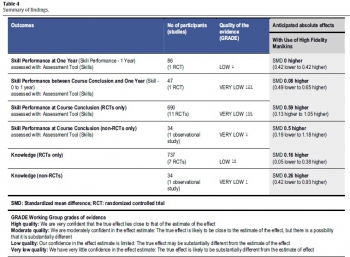
Conclusion:
The use of high fidelity manikins for advanced life support training is associated with moderate benefits for improving skills performance at course conclusion. Future research should definethe optimal means of tailoring fidelity to enhance short and long term educational goals and clinical outcomes.
| Tags : simulateurs
04/04/2015
Simulateur de tâche: Modifié pour + de réalisme!
Rescuing the obese or burned airway: are conventional training manikins adequate? A simulation study
Howes TE. et Al. Br J Anaesth. 2015 Jan;114(1):136-42
-------------------------------------------------
L'emploi de simulateurs de taches se heurte au problème du réalisme de ces derniers. Cette équipe propose de modifier les simulateurs industriels pour plus de réalité.
-------------------------------------------------
Background. Percutaneous tracheal access is required in more than 40% of major airway emergencies, and rates of failure are high among anaesthetists. Supraglottic airway management is more likely to fail in patients with obesity or neck pathology. Commercially available manikins may aid training. In this study, we modified a standard ‘front of neck’ manikin and evaluated anaesthetists’ performance of percutaneous tracheal access.
Methods. Two cricothyroidotomy training manikins were modified using sections of belly pork to simulate a morbidly obese patient and an obese patient with neck burns.

An unmodified manikin was used to simulate a slim patient. Twenty consultant anaesthetists were asked to manage a ‘can’t intubate, can’t ventilate’ scenario involving each of the three manikins. Outcome measures were success using their chosen technique and time to first effective breath.
Results. Success rates using first-choice equipment were: ‘slim’ manikin 100%, ‘morbidly obese’ manikin 60%, and ‘burned obese’ manikin 77%. All attempts on the ‘slim’ manikin succeeded within 240 s, the majority within 120 s. In attempts on the ‘morbidly obese’ manikin, 60% succeeded within 240 s and 20% required more than 720 s. All attempts on the ‘burned obese’ manikin succeeded within 180 s.
Conclusions. Significantly greater technical difficulty was experienced with our ‘morbidly obese’ manikin compared with the unmodified manikin. Failure rates and times to completion were considerably more consistent with real-life reports. Modifying a standard manikin to simulate an obese patient is likely to better prepare anaesthetists for this challenging situation. Development of a commercial manikin with such properties would be of value
| Tags : coniotomie
Crico: S'entraîner sur un modèle animal est pertinent ?
Comparison of manikin versus porcine models in cricothyrotomy procedure training
Cho J et Coll. Emerg Med J 2008;25:732-734
--------------------------------------------------------------------------
Le choix du simulateur de tache utilisé pour l'enseignement de la coniotomie reste une vrai question. Modèle humain, animal ou artificiel. Cet article met en avant l'intérêt du modèle animal qui offrirait plus de réalité anatomique. Néanmoins il faut lire ce document avec un peu de recul car la coniotomie est un geste peu fréquemment réalisé, et probablement que la notion de réalisme porte plutôt sur les aspects anatomiques de la région cervicale que sur le réalisme de pratique de geste sur la région cervicale. Encore faut-il pouvoir dans la vrai vie pouvoir disposer d'une filière d'approvisionnement qui souvent se résume au boucher du quartier.
--------------------------------------------------------------------------
Objective: To compare the usefulness for training of a porcine model (larynx, trachea, and pig skin) and a manikin model using a Portex cricothyrotomy kit (PCK).
Methods: In a prospective randomised crossover trial, participants in the airway workshop performed crico-thyrotomy using a PCK on the porcine and manikin models (Tracheostomy Trainer and Case). The porcine model was made with larynxes and trachea from freshly slaughtered pigs and covered with a piece of thinned pigskin stapled to a wooden board.
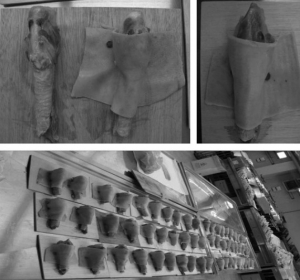
Participants were asked to assess the following: reality of skin turgor; difficulty with skin penetration, landmark recognition and procedure; reality of the model; and preference for each model using a visual analogue scale (VAS) of 0–10 cm. The VAS scores for each model were compared.
Results: 49 participants were included in the study. Mean (SD) VAS scores for the reality of skin turgor, degree of difficulty with skin penetration and landmark recognition were higher with the porcine model than with the manikin model (7.0 (2.1) vs 4.7 (2.0), 6.4 (2.4) vs 3.6 (2.2), 5.1 (2.2) vs 4.2 (2.5), respectively). There was no difference between the models in the difficulty of the procedure (5.0 (2.4) vs 4.7 (3.2)). The porcine model had a higher VAS score for overall reality and preference of the model (7.1 (2.0) vs 4.8 (2.3) and 7.1 (2.0) vs 4.8 (2.2), respectively).

Conclusion: The porcine model is a more useful training tool than the manikin model for cricothyrotomy with PCK because of its reality and similarity to human anatomy.
| Tags : coniotomie
Simulateur de crico: Encore le modèle porcin
A home-made animal model in comparison with a standard manikin for teaching percutaneous dilatational tracheostomy
Interact Cardiovasc Thorac Surg. 2015 Feb;20(2):248-53

| Tags : coniotomie, simulateurs
22/03/2015
L'échographie: Investir de son temps pour avoir une pratique fiable
Ultrafest: A Novel Approach to Ultrasound in Medical Education Leads to Improvement in Written and Clinical Examinations
Connolly K et All. West J Emerg Med. 2015 Jan;16(1):143-8.
----------------------------------------------------------------------------------
L'apprentissage de l'échographie est un impératif en médecine d'urgence. Cependant une véritable qualification ne peut être obtenue qu'au travers de formations universitaires assorties de pratiques réelles et régulières. La pratique des certains protocoles simplifiés comme le FAST serait d'acquisition plus simples. Aussi sont souvent proposées des formations de courtes durées. Ces dernières semblent en théorie très intéressantes en contexte militaire. Une analyse raisonnée de la réalité doit tempérer cet enthousiasme. Le travail présenté montre que si les connaissances théoriques des étudiants sont améliorées par une formation d'une journée, cette dernière ne permet pas l'acquisition d'une pratique suffisamment fiable. Ainsi la formation de nos personnels, qui repose souvent sur des formations de courtes durée, doit elle vue comme une découverte de cette pratique et non pas comme permettant l'acquisition d'un réel savoir faire.
Introduction:
Our objective was to evaluate the effectiveness of hands-on training at a bedside ultrasound (US) symposium (“Ultrafest”) to improve both clinical knowledge and image acquisition skills of medical students. Primary outcome measure was improvement in multiple choice questions on pulmonary or Focused Assessment with Sonography in Trauma (FAST) US knowledge. Secondary outcome was improvement in image acquisition for either pulmonary or FAST.
Methods:
Prospective cohort study of 48 volunteers at “Ultrafest,” a free symposium where students received five contact training hours. Students were evaluated before and after training for proficiency in either pulmonary US or FAST. Proficiency was assessed by clinical knowledge through written multiple-choice exam, and clinical skills through accuracy of image acquisition. We used paired sample t-tests with students as their own controls.
Results:
Pulmonary knowledge scores increased by a mean of 10.1 points (95% CI [8.9-11.3], p<0.00005), from 8.4 to a posttest average of 18.5/21 possible points. The FAST knowledge scores increased by a mean of 7.5 points (95% CI [6.3-8.7] p<0.00005), from 8.1 to a posttest average of 15.6/ 21. We analyzed clinical skills data on 32 students. The mean score was 1.7 pretest and 4.7 posttest of 12 possible points. Mean improvement was 3.0 points (p<0.00005) overall, 3.3 (p=0.0001) for FAST, and 2.6 (p=0.003) for the pulmonary US exam.
Conclusion:
This study suggests that a symposium on US can improve clinical knowledge, but is limited in achieving image acquisition for pulmonary and FAST US assessments. US training external to official medical school curriculum may augment students’ education
| Tags : échographie
21/03/2015
Simulateur ou vecteur biologique ?
Randomized objective comparison of live tissue training versus simulators for emergency procedures
Hall AB. Am Surg. 2011 May;77(5):561-5.
-----------------------------------------------------------------------------------------
La simulation joue un rôle fondamental dans la foration aux gestes du sauvetage au combat. Le recours au vecteur biologique, au cadavre ou à des simulateurs artificiels reste sujet à débat. Le travail proposé montre que les simulatueurs artificiels sont aussi efficaces que les vecteurs biologiques. L'emploi de cadavres apparaît quand à lui poser le problème de leur disponibilité en nombre suffisant.
-----------------------------------------------------------------------------------------
There is a lack of objective analysis comparing live tissue and simulator training. This article aims to objectively determine the difference in outcomes. Twenty-four Air Force volunteers without prior experience performing emergency procedures were randomly assigned to receive training in tube thoracostomy (chest tube) and cricothyroidotomy training on either a pig model (Sus scrofa domestica) or on the TraumaMan simulator. One week posttraining, students were tested on human cadavers with objective and subjective results recorded. Average completion time for tube thoracostomy in the animal model group was 2 minutes 4 seconds and 1 minute 51 seconds in the simulator group with a mean difference of 12 seconds (P = 0.74). Average completion time for cricothyroidotomy in the animal model group was 2 minutes 35 seconds and 3 minutes 29 seconds in the simulator group with a mean difference of 53 seconds (P = 0.32). Overall confidence was 9 per cent higher in the animal trained group (P = 0.42). Success rate of cricothyroidotomy was 75 per cent in the animal model group and 58 per cent in the simulator-trained group (P = 0.67). Success rate of chest tube placement was 92 per cent in the animal group and 83 per cent in the simulator group (P = 1.00). There was no statistically significant difference in chest tube and cricothyroidotomy outcomes or confidence in the groups trained with live animal models or simulators at the 95 per cent confidence interval. Trends suggest a possible difference, but the number of cadavers required to reach greater than 95 per cent statistical confidence prohibited continuation of the study.
| Tags : simulateurs
13/03/2015
Simulation, simple est possible: La coniotomie
Il existe de nombreux simulateurs de coniotomie commerciaux. Ils sont onéreux tant à l'achat que dans leur entretien. Faire simple et peu onéreux est possible.
Premier exemple:
| Tags : coniotomie
Simulateur de crico: Un modèle animal facile
An Innovative and Inexpensive Model for Teaching Cricothyrotomy
Wang E. et Al Simul Healthc. 2007 Spring;2(1):25-9
Une trachée animale: Ici de boeuf

On couvre avec un emballage souple
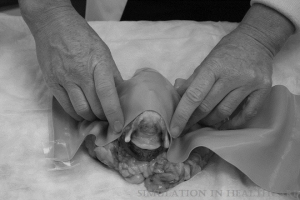
On s'entraîne
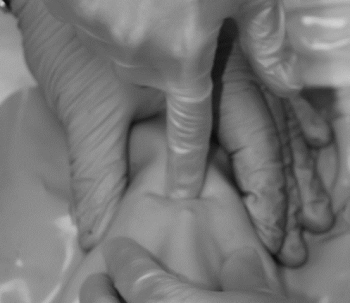
| Tags : coniotomie

